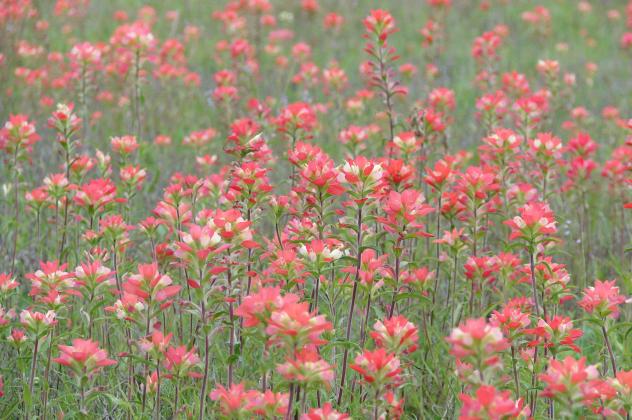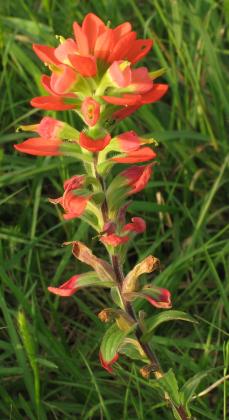Castilleja indivisa – Roll out the red carpet
Backyard Horticulture
Castilleja indivisa, Texas Indian paintbrush, TIP, is a Texas native appearing as a bright red carpet along Central Texas highways in spring and early summer. Their beauty, especially when combined with bluebonnets, makes driving on Grimes County roads a pleasure and brings many visitors. The Texas Department of Transportation, TxDOT, broadcasts TIP and other wildflower seeds. They distribute 2 pounds of TIP seeds per acre with 5,100,000 (yes, million) dust-sized seeds per pound. More information is in the TxDOT document “South Texas Brush Country Seed List” at txdot.gov.
In colors ranging from yellow to purple, the Castilleja genus has about 200 species, Castilleja spp. TIP is usually 8 to 12 inches tall. Leaves, ¾ inch to 2 inches, attach directly to the stem with no stalk. It’s the bright red bracts that we see. The real flowers are small, white or yellow. The only part of the flower that’s visible is the upper part as it pokes above the bract.
At first Castilleja spp. gets nutrients from ordinary roots. When they touch the roots of another plant, a modified root called haustoria develops. It taps into the root system of the host plant to absorb its nutrients. Plants with this lifestyle are known as semi- or hemiparasitic. TIP can live without a host but will not thrive and may not bloom. Host plants are often grasses and bluebonnets. This lifestyle makes TIP difficult to cultivate and is why TxDOT sows so many TIP seeds per acre.
An important nectar source, flowers are pollinated by butterflies, hummingbirds, and bees. TIP has edible flowers that were eaten by Native Americans as a condiment or mixed with fresh greens. Some sucked the flowers’ nectar. TIP roots and green parts are potentially toxic because they concentrate selenium. Selenium is found naturally in many foods and is a necessary nutrient. Most Americans get enough selenium from their diet. The National Institutes of Health Office of Dietary Supplements, ods.od.nih.gov, has selenium information in their article, “Selenium Fact Sheet for Consumers.” Castilleja spp. is in the Food and Drug Administration Poisonous Plant Database at fda.gov.
Traditional medicine systems use TIP for healthy hair, rheumatism, skin diseases, the immune system, etc. More information about Castilleja spp. is at the Native American Ethnobotanical Database at naeb.brit.org and the National Institutes of Health at ncbi.nlm.nih.gov.
The name Indian paintbrush is from a Native American legend about an artist who asked the Great Spirit for the ability to paint a beautiful sunset. He only had earth-tone paints made of pounded minerals and brushes too stiff to make delicate movements. In a dream he was given a white deerskin to use as a canvas and told to go to the hillside to paint. The next day he did this and found the canvas and paintbrushes with beautiful colors. As he worked, he dropped the brushes in the grass. The painting was a masterpiece. Later, he found that where he had dropped the brushes were flowers in every color of the sunset.
Deborah Richardson is a freelance reporter for The Examiner with a fondness for flora in its natural setting.





